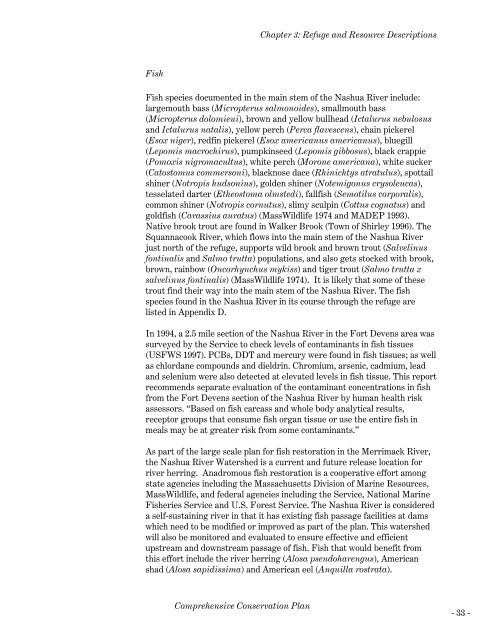Oxbow NWR Final CCP - U.S. Fish and Wildlife Service
Oxbow NWR Final CCP - U.S. Fish and Wildlife Service
Oxbow NWR Final CCP - U.S. Fish and Wildlife Service
Create successful ePaper yourself
Turn your PDF publications into a flip-book with our unique Google optimized e-Paper software.
<strong>Fish</strong><br />
Chapter 3: Refuge <strong>and</strong> Resource Descriptions<br />
<strong>Fish</strong> species documented in the main stem of the Nashua River include:<br />
largemouth bass (Micropterus salmonoides), smallmouth bass<br />
(Micropterus dolomieui), brown <strong>and</strong> yellow bullhead (Ictalurus nebulosus<br />
<strong>and</strong> Ictalurus natalis), yellow perch (Perca flavescens), chain pickerel<br />
(Esox niger), redfin pickerel (Esox americanus americanus), bluegill<br />
(Lepomis macrochirus), pumpkinseed (Lepomis gibbosus), black crappie<br />
(Pomoxis nigromacultus), white perch (Morone americana), white sucker<br />
(Catostomus commersoni), blacknose dace (Rhinichtys atratulus), spottail<br />
shiner (Notropis hudsonius), golden shiner (Notemigonus crysoleucas),<br />
tesselated darter (Etheostoma olmstedi), fallfish (Semotilus corporalis),<br />
common shiner (Notropis cornutus), slimy sculpin (Cottus cognatus) <strong>and</strong><br />
goldfish (Carassius auratus) (Mass<strong>Wildlife</strong> 1974 <strong>and</strong> MADEP 1993).<br />
Native brook trout are found in Walker Brook (Town of Shirley 1996). The<br />
Squannacook River, which flows into the main stem of the Nashua River<br />
just north of the refuge, supports wild brook <strong>and</strong> brown trout (Salvelinus<br />
fontinalis <strong>and</strong> Salmo trutta) populations, <strong>and</strong> also gets stocked with brook,<br />
brown, rainbow (Oncorhynchus mykiss) <strong>and</strong> tiger trout (Salmo trutta x<br />
salvelinus fontinalis) (Mass<strong>Wildlife</strong> 1974). It is likely that some of these<br />
trout find their way into the main stem of the Nashua River. The fish<br />
species found in the Nashua River in its course through the refuge are<br />
listed in Appendix D.<br />
In 1994, a 2.5 mile section of the Nashua River in the Fort Devens area was<br />
surveyed by the <strong>Service</strong> to check levels of contaminants in fish tissues<br />
(USFWS 1997). PCBs, DDT <strong>and</strong> mercury were found in fish tissues; as well<br />
as chlordane compounds <strong>and</strong> dieldrin. Chromium, arsenic, cadmium, lead<br />
<strong>and</strong> selenium were also detected at elevated levels in fish tissue. This report<br />
recommends separate evaluation of the contaminant concentrations in fish<br />
from the Fort Devens section of the Nashua River by human health risk<br />
assessors. “Based on fish carcass <strong>and</strong> whole body analytical results,<br />
receptor groups that consume fish organ tissue or use the entire fish in<br />
meals may be at greater risk from some contaminants.”<br />
As part of the large scale plan for fish restoration in the Merrimack River,<br />
the Nashua River Watershed is a current <strong>and</strong> future release location for<br />
river herring. Anadromous fish restoration is a cooperative effort among<br />
state agencies including the Massachusetts Division of Marine Resources,<br />
Mass<strong>Wildlife</strong>, <strong>and</strong> federal agencies including the <strong>Service</strong>, National Marine<br />
<strong>Fish</strong>eries <strong>Service</strong> <strong>and</strong> U.S. Forest <strong>Service</strong>. The Nashua River is considered<br />
a self-sustaining river in that it has existing fish passage facilities at dams<br />
which need to be modified or improved as part of the plan. This watershed<br />
will also be monitored <strong>and</strong> evaluated to ensure effective <strong>and</strong> efficient<br />
upstream <strong>and</strong> downstream passage of fish. <strong>Fish</strong> that would benefit from<br />
this effort include the river herring (Alosa pseudoharengus), American<br />
shad (Alosa sapidissima) <strong>and</strong> American eel (Anquilla rostrata).<br />
Comprehensive Conservation Plan<br />
- 33 -

















